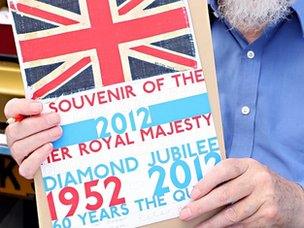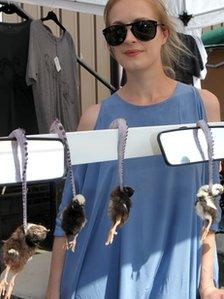Bagging a bargain at the Art Car Boot Fair
- Published
Sir Peter Blake, Polly Morgan, Jessica Albarn and Gavin Turk tell BBC News why they keep coming back to the Art Car Boot Fair
Imagine a car boot sale and you probably think of wallpaper tables covered in cheap tat.
But the Art Car Boot Fair is a spin on the traditional sale. Instead of bric-a-brac, limited edition artworks by top British artists are sold from the back of their motors.
Created and curated by Karen Ashton, the one-day fair spawned from an idea to hold a London-to-Brighton car rally with a boot sale afterwards.
It has been running annually in London since 2004 and has just held its ninth edition.
More than 70 British artists participated this year including Sir Peter Blake, Tracey Emin, Gavin Turk, Polly Morgan, Mat Collishaw and Bob & Roberta Smith.
Artists can only have a pitch by invite and, although they don't have to pay a fee, they have to be in attendance on the day to sell their work.
The event is sponsored by Vauxhall, who provide the motors - both new and classic - for the stalls to be set up around.
The other similarity with the traditional car park jumble sale is that the artworks are sold for knockdown prices - with pieces changing hands for as little as £10.

Sir Peter Blake's limited edition souvenir print was on sale for £40
With the draw of big-name artists, more than 4,000 art-lovers attended the event with some queuing for hours to get their hands on affordable works. Some even camped overnight.
First in line were Taylor Wright and Josh Wright, both 18 years old from High Wycombe (although unrelated, despite the surname). They started the queue at 01:00 on Sunday morning to ensure they would be the first in line.
"We wanted to grab a bargain and meet some artists," said Josh, who was armed with a wishlist of artworks.
"I'm quite poor so I'm only going for a Peter Blake today," Taylor Wright added.
A quick straw poll of the queue found most people were also after a print by the 79-year-old, best known for his Sgt Pepper's record sleeve.
His work - revealed on the day - was an A4 souvenir poster of the car boot fair which this year also celebrated the Queen's Jubilee.
Limited to a signed edition of just 250, they were being sold for a mere £40 - and all were snapped up in just over an hour.
Sir Peter has been to the fair every year since it began (excluding last year, when he was too ill to attend) and first sold wood engravings before becoming known for prints marking the event.
<bold>'Democratising art'</bold>
For Sir Peter, the fair was a "nice day out"; a chance to catch up with old friends and meet some new ones.
Gavin Turk, who rose to prominence during the so-called Young British Artists wave during the 1990s, shared his sentiment.
"I love the fact that the artists themselves come and sell their own work," he said.

Polly Morgan created her own take on furry dice - pheasant chicks strangled by octopus tentacles
"It somehow democratises art and makes it available to more people and helps the audience understand art."
Taxidermy artist Polly Morgan agreed: "It means people who can't normally afford to buy your bigger work can get something and it's a fun day out."
As well as giving artists the chance to meet the people who buy their artwork, the fair also allows them to create pieces they may not ordinarily produce for an exhibition.
Morgan presented a new edition at the sale, giving her take on the furry dice - pheasant chicks being strangled by octopus tentacles. Just the sort of thing you'd want to hook on your rear-view mirror.
Some artists also created live works at the fair, including graffiti artist Pure Evil - recently featured on BBC One's The Apprentice - who produced signed screen prints for £20 out the back of his bright orange van.
Jessica Albarn, sister to Blur frontman Damon Albarn, also gave a drawing performance in a garden shed.
As well as creating some limited edition packets of wildflower seeds to raise funds for the Bumblebee Conservation Trust, she spent the day drawing the insects and sold them as originals.
"I like the spirit of the fair," Albarn said.
"It's nice for artists to represent themselves and sell our wares without going through a gallery and you have a bit of freedom to have fun."
<bold>Secondary market</bold>
With art up for grabs at relatively cheap prices, a proportion of it inevitably ends up on auction sites with sellers hoping for a quick profit.
Last year, limited edition Damien Hirst prints sold at the fair for a meagre £300. They were changing hands just days after for £3,000.
"The whole point of selling them cheap is you hope people like and keep them, and it gives them the chance to buy something," said Sir Peter.

Graffiti artist Pure Evil produced signed prints on the day form the back of his van for £20
"Certainly in the first years there were people who would come and buy four or five, but we recognise them now so we only sell one. They go on eBay and I don't like that, but it's going to happen."
Morgan added: "It's a shame some people do it quite so cynically but I guess if they've been queuing for many hours or camped out overnight maybe they deserve a bit of money back."
"People that buy it for twice the price are quite foolish because they could probably buy something direct from the artist for less than that."
Turk also suggested immediate sales on the secondary market may not be a bad thing: "In a way, the fact the art ends up on eBay is almost quite exciting as it means the marketplace carries on even after the fair."
"But on the whole, most people are buying it for themselves."
Early queuers Taylor Wright and Josh Wright said they had no intention of selling their purchases after managing to snap up exactly what they wanted.
"I got a Sir Peter Blake Jubilee print so I'm very happy," Taylor said. "I'm going to try and get a nice frame and keep it at home because I like it."
Josh added: "I got a Peter Blake as well and a Marcus Harvey edition of five - so it paid off coming really early."
The fair is expected to return next year with a retrospective to celebrate its 10th birthday.
- Published2 April 2012
- Published26 May 2012